Why Are Whites Committing Suicide?
Jared Taylor, American Renaissance, January 31, 2020
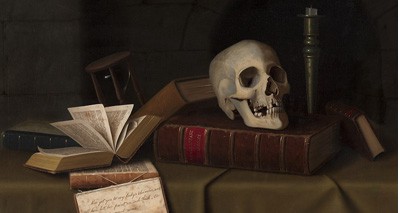
Kevin MacDonald, Individualism and the Western Liberal Tradition: Evolutionary Origins, History, and Prospects for the Future, Kindle Direct Publishing Edition, 2019, 525 pp., $24.95 (soft cover).
Years ago, I got to know a black separatist named Robert Brock. He didn’t like white people, but he seemed to like me. I think he respected my honesty. We had a few long phone conversations, and once he asked me point-blank: “I think it’s great, of course, but why are white people committing suicide?” I told him I didn’t know but congratulated him on seeing so clearly something that most whites refuse to see.
Why are white people committing suicide? Kevin MacDonald’s new book, Individualism and the Western Liberal Tradition, does not set out explicitly to answer that question, but it is a thorough study of the origins and implications of a trait that has made Western man great but that also makes him uniquely vulnerable to exploitation: individualism. This is a sprawling book of more than 500 pages that sometimes repeats itself or wanders off topic, but it is an invaluable and always interesting attempt to understand who we are — and why.
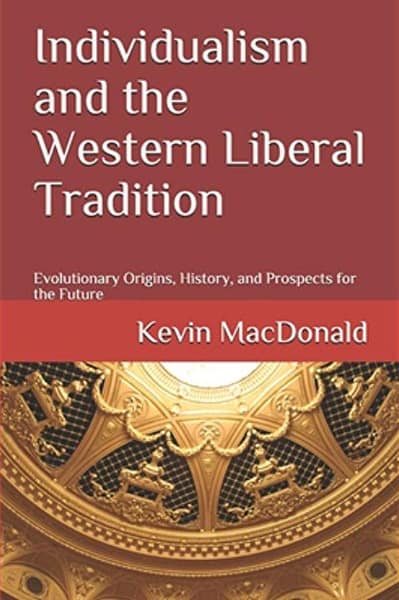
Prof. MacDonald argues that there are both genetic and cultural reasons for Western individualism. Europeans are a melding of several populations. The primordial Europeans are known as Western Hunter-Gatherers, who arrived on the continent some 45,000 years ago. They displaced the Neanderthals, who had come 350,000 years earlier, but bred with them and acquired a small amount of their DNA. Farmers first arrived about 8,000 years ago, probably from Asia Minor, but were different from the people who now live in Asia Minor.
The most influential early settlers were the Indo-Europeans, often referred to as the Yamnaya people, who came some 4,500 years ago as conquerors from the area north of the Black Sea. They did not exterminate the people they conquered; they took their women and enslaved the men, eventually merging with local populations but leaving behind their distinctive individualist culture. Studies of ancient DNA have found a north-to-south gradient of Yamnaya genes, with modern Norwegians about 55 percent Yamnaya and Sardinians only about 10 percent.
The original Indo-Europeans were tall, with European features, but dark-eyed and probably darker skinned than today’s Europeans. They appear to have picked up light-colored eyes and skin mainly from the Western Hunter-Gatherers with whom they bred.
The harsh climate of northern Europe led to a unique form of social organization. Barren lands did not support large family groups, and nomads often met other groups. This meant it was common to deal with strangers, and this was a crucial element in the development of Western individualism. Small family groups could not survive if they were constantly battling each other, and Europeans developed trust-based societies, in which people treated kin and non-kin more or less equally. A European might meet many strangers during his life — some repeatedly — so it was a matter of mutual survival to offer — and expect — fair dealing rather than hostility. It was therefore important to have a reputation for fairness.
In the Orient, the environment supported larger kinship groups, and people lived within the tribe. They were loyal to this extended family, suspicious of outsiders, and developed a clear, ingroup-outgroup morality that we can call ethnocentrism. As Prof. MacDonald notes, “In collectivist, family-oriented societies, trust ends at the border of the family and the wider kinship group.”
The less demanding Oriental environment made it easier for able men to accumulate enough property to support several wives. In polygamous societies, almost all women married — and married young — with wives becoming part of the husbands’ households. Marriage was also within the tribe, and elders often chose spouses in ways that cemented family alliances. Cousin marriage — common in the East — was a common way to build family alliances of closely related people.
Europeans developed a different family structure. It was hard to amass enough wealth to support more than one wife so even chiefs were monogamous. Married couples started their own households, so they could not marry until they had enough property. They therefore married later and chose spouses for love rather than to build alliances. The tradition of romantic love between one man and one woman is uniquely Western and is found in the earliest records. European women were not family property to be given away to the highest bidder and were treated far more equally to men than in the East.
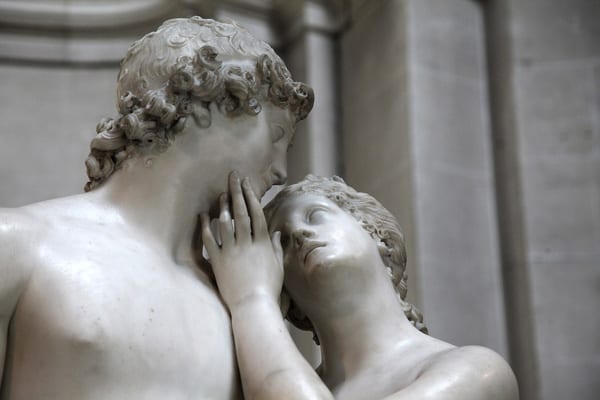
“Venus and Adonis” by Antonio Canova (1795).
European men were not rich enough to keep wives in unproductive seclusion as was common in harems or under the system of purdah in India. Wives worked and had contact with other men. Men therefore had to be able to trust their wives if they were to be sure their children were their own. All societies praise “virtuous” women, but with the relative freedom European women enjoyed, their “virtue” was not controlled by eunuchs but had to come from within.
At the same time, Europeans have a greater variety of coloration than people of any other continent, and this may have been a key to paternity. A husband might be able to tell immediately if his child were a bastard.
Just as there is a north-south genetic gradation in Europe, there is a north-south gradation in family patterns, with individualism most pronounced in the north. Towards the south, there is a greater tendency towards earlier marriage, family choice of spouses, and wives moving in with their husbands’ families.
It would be wrong to think that high trust, monogamy, and love marriages were imposed on Europeans by Indo-Europeans. As Prof. MacDonald points out, Indo-Europeans conquered Asia as well, but with tribal, collectivist results. Prof. MacDonald suggest that the original Europeans may have already been genetically more receptive to individualism, but climate was surely important.
Also, high trust and fair dealing did not extend beyond a certain perimeter. Strangers who were far enough away were fair game for plunder. A key element of Indo-European society was the Mannerbund, which Prof. MacDonald defines as the “all-male war band that set out to achieve fame and fortune by conquering other territories.” The Mannerbund was led by a chief who earned his position through prowess in war, and for whom fame through combat was the highest goal.
Kinship was not important for the Mannerbund. Followers could join or defect, according to the abilities of the chief, who could be deposed or disobeyed if his men thought his judgment was wrong. Prof. MacDonald explains:
The novelty of Indo-European culture was that it was based neither on centralized kingship nor clan-type extended kinship groups, but on an aristocratic elite that was egalitarian within the group. Critically, this elite was not bound by kinship as would occur in a clan-based society, but by the pursuit of fame and fortune . . . The men who became leaders were not despots, but peers of other warriors — an egalitarianism among aristocrats.
This was a genuine first-among-equals system, in which any man of ability could hope to be a leader. It also inspired intense loyalty. It was common for followers to vow that if their chief fell in battle, they would fight on until they had avenged him or until all were dead. Devotion of this kind could be won only by men who generously shared the spoils of war, who suffered the same privations as his men, and had a talent for planning and generalship. Kinship did not matter; prowess was everything.
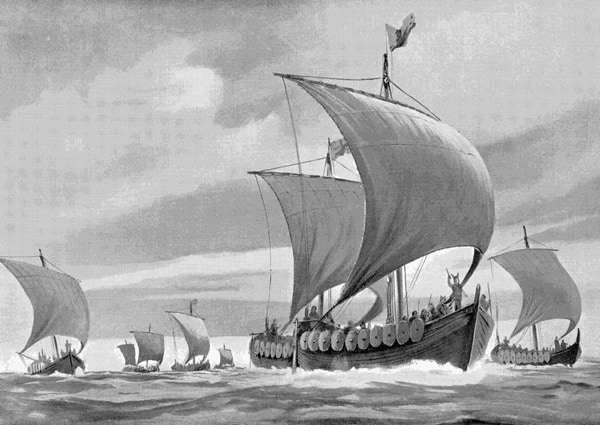
A fleet of Viking ships on a raid. From Hutchinson’s History of the Nations, published 1915. (Credit Image: © Ken Welsh/Design Pics via ZUMA Wire)
This was an aristocratic but also meritocratic society, militarized and hypermasculine. Boys were reared to be warriors, to smite their enemies, take their cattle, and ravish their women. The better the warrior, the better his chances of marrying a strong and beautiful woman and accumulating the wealth to rear healthy children. Nazis thought the Mannerbund was the ideal male group.
A chief’s sons did not necessarily inherit his wealth or position. Often, two-thirds of a chief’s wealth was burned in his funeral pyre. According to Icelandic saga, sons of kings could inherit land but not money. If they wanted wealth, they had to conquer it for themselves. A king also had to be seen as governing for the good of all in order to retain authority; there were no dictators. Even in the earliest Icelandic system, a peasant could sue a lord for justice and wives could sue husbands for divorce.
In the East, the Indo-Europeans became Oriental despots. Only the king was attributed heroic qualities, and all commoners and foreigners were made to prostrate themselves before him. He compelled his subjects to fight for him — they had no choice. Women were property. Powerful men had many; poor men had none.
Prof. MacDonald says that the aristocratic but egalitarian ethos dominated European culture, right up through the Middle Ages. Of course, as kings consolidated power, they became autocratic and society became more stratified. Rulers became clan-like elites, but Indo-European individualism persisted.
The Church
The Catholic Church had a profound influence on Europe. There has probably never been a religious organization that exercised nearly as much secular power, and the Church did it in a peculiar way: Celibate men regulated the reproductive behavior of even the most powerful men. It forced strict sexual morality and rigid monogamy on everyone.
Prof. MacDonald notes that a harsh environment imposed monogamy on early Europeans, but by the time of the Middle Ages, kings had more than enough wealth to keep harems, but the church forbade polygamy and kings obeyed. The church also forbade divorce, inheritance by bastards, and marriages to close kin that could have created royal tribal alliances. It insisted on consent of both partners. Priests and bishops thus usurped the powers of heads of families and heads of kingdoms.
How did the church get this power? Prof. MacDonald argues that clerics governed a military aristocracy through force of example. At the height of its powers, from about 1000 to 1200, the church was run by men who, through vows of poverty and chastity, demonstrated their own renunciation of wealth and women. The austere life of the monastery gave the church immense prestige; self-denial led to immense moral power. As Prof. MacDonald explains, “Ultimately, the credibility of the Church depended on an image of ascetic, celibate clergy.” Ordinary people were impressed by clerical abstinence and believed deeply in the church. They might turn on a king who flouted religious law; Pope Gregory VII (1073 to 1085) could plausibly claim the power to depose emperors.
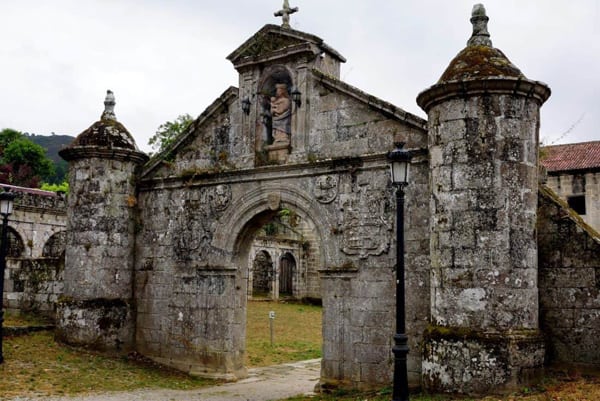
An astonishing number of wealthy and powerful men — and women — gave up all earthly advantages and went into monasteries. The children of aristocrats became mendicant friars who begged for a living. Moral perfection was the highest goal for these people, and if they were seen as sincerely pursuing perfection, they had immense prestige.
At the same time, Christianity subverted aristocratic values because all were equal before God. Status was based on sanctity, not on birth, rank, or prowess in battle. Christian heroes were the opposite of Indo-European conqueror-heroes: They were martyrs, praying for the forgiveness of their enemies as they meekly accepted death. And when aristocrats went into monasteries, they worked fields, cooked, and chopped wood. This reverse the traditional aristocratic contempt for manual labor. Likewise, in a world in which all were servants of God, even the poor had a right to Christian charity. As Prof. MacDonald explains, “The church had created a moral community based on egalitarianism and universalism.”
Although the church was built on revealed dogma, it remained intensely rational, with fierce debates about doctrine. Prof. MacDonald calls this the intellectual legacy of early European individualism, in which even within the church there was limited but vigorous dissent. Thomas Aquinas even thought up scientific proofs for the existence of God; no other religions ever attempted such a thing.
At the height of its power, the church became collectivist in a way that was uncharacteristic of Europeans. The Crusades were a vast, collective campaign, as was the vivid sense of separateness from Jews. Still, the church, especially after the Reformation, was ultimately a force for individualism because of the Christian conviction of equality before God.
Puritanism
Prof. MacDonald argues that Puritanism almost entirely wiped out the final traces of the ancient Indo-European way of life — at least among English speakers. In Britain, it was Cromwell’s revolt against the King; in the United States it was the legacy of the Plymouth Rock Pilgrims.
Puritans were highly collectivist, with harsh punishments for religious or moral dissenters, but very egalitarian within the group. Congregations elected their pastors; all people had potentially equal worth, with honorable social roles to play. Moral behavior was the supreme goal in life and was pleasing to God; proper instruction pointed the way to virtue. Puritans started Harvard college only six years after founding the colony, and an early law required every town of at least 50 families to hire a schoolmaster.
Massachusetts Puritans were homogenous. They were mainly from the same part of England and were almost all middle-class. They were insular and inward-looking and thought of themselves as God’s chosen people. For the first 70 years of its existence, the Massachusetts colony had the right to expel Anabaptists, Quakers, or anyone else of whom it disapproved, and to put them to death if they returned. As one cleric put it, “No man hath a right to come into us without our consent.”
The Puritans established the classic form of what Prof. MacDonald calls a “moral community.” It was not based on kinship, but on shared beliefs that the community policed with great vigilance. The Puritans did not exclude blacks or Indians — they tried to convert them — but few joined.
Prof. MacDonald calls Puritanism “the most important cultural influence in the United States from the eighteenth century down to the mid-twentieth century.” This is because it:
destroyed the old tri-partite Indo-European order based on domination of a military elite . . . . the Indo-European world and its Christian version: the king and aristocracy . . . and the commoners. . . . It was thus the quintessential modern revolution, and because of the rise of Britain into a dominant world power, it was a fundamental break in the history of the West. It marked the beginning of the end of aristocratic individualism . . . and the beginning of the rise of egalitarian individualism and its ideology of social leveling and parliamentary democracy . . . .
Even war became democratic. Cromwell’s New Model Army was not a professional warrior class but an army of citizens. The end of aristocracy had benefits. Prof. MacDonald writes that with hereditary obstacles removed, Europe became open to contributions from everyone, which led to a flowering of science, technology, art, and the trades. Ideas and schools of thought clashed openly and capitalism flourished. None of this was possible in a Middle-Ages semi-theocracy or in a collectivist Oriental society.
However, this new freedom did not end the intense morality of the “moral community.” Puritans fought a holy war against the forces of evil, and this tradition continues. Prof. MacDonald finds Puritan roots in the zealotry of everything from “the war to end all wars,” to the war on drugs, and the current craze to end every conceivable form of “racism.”
The abolition movement of the 19th century was a characteristically Puritan crusade. As Prof. MacDonald notes, it was the first time that a group of people worked up a sustained moral passion in defense of someone else’s rights. To this day, this is probably a uniquely European phenomenon, and this is the sort of campaign on which the “moral community” thrives. Even in the 18th century, there were already strong uplift movements — charity hospitals, orphanages — but nothing matched the zeal to end slavery. Marxists assume that every human motive is based on class selfishness, but whites gained nothing but moral satisfaction from abolition.
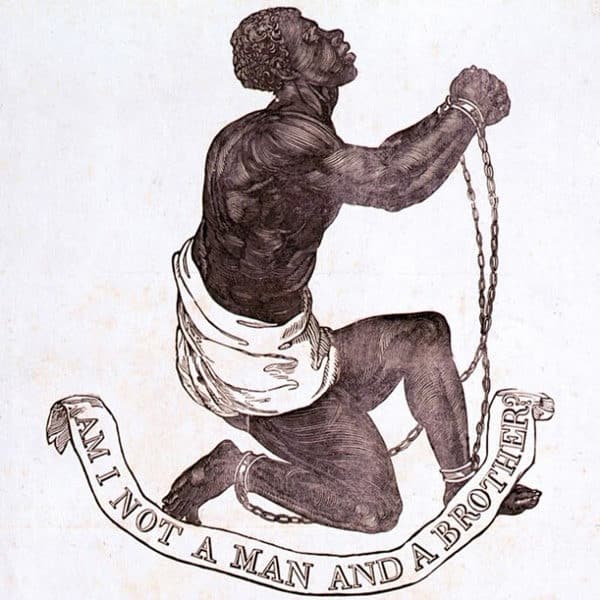
Emblem produced by Josiah Wedgwood as part of an anti-slavery campaign.
Abolition was also explicitly universalist: Slaves were “our oppressed brothers,” and as the Transcendentalist preacher Theodore Parker insisted, “God is alive in every person.” By 1780, people on both sides of the Atlantic could make a career of fighting slavery as part of a movement that preserved Puritan moral fervor. Women were especially ardent abolitionists.
Racial and social egalitarianism went together: Many people began to believe that crime and poverty were not personal vices but indictments of an unjust society.
In the United States, egalitarian universalism meant acceptance of immigrants — though from Europe. The WASP elite considered itself superior to European ethnics but believed Italians and Irishmen could be made into good Americans. Again, community was not based on kinship, but on common values. Prof. MacDonald argues that “these model communities are indigenous products of the culture of the West — products of Western culture in the same way that kinship-based clans, cousin marriage, sequestering women, and the harems of elite males are products of the people of the Middle East.”
A pernicious legacy
The trouble with universalism is that it can be turned against its inventors. Jews, blacks, and other non-whites remain tribal, despite an ethos of universal brotherhood. Prof. MacDonald writes: “The Puritan legacy in American culture is indeed pernicious because, once the puritan-descended intellectual and financial elite had been displaced, their moral idealism . . . was vulnerable to hijacking by intellectual and political movements aimed at replacing the traditional peoples of the United States.”
Outsiders were certainly undermining any sense among the American founding stock that they had a moral claim to their own country, but there was betrayal from within. From the early 20th century, influential WASPs argued that whites did not have an identity worth preserving.
We now live in a moral community that is radically opposed to the interests of whites, yet whites continue to be too individualistic to fight back. Universities, in particular, have become hives of anti-white mania. This was presaged by the takeover of all important anthropology departments by disciples of Franz Boas, which was complete in the 1920s. Prof. MacDonald warns that ”The academic world has become a Puritan congregation of stifling thought control, enforced by moralistic condemnations that a Puritan minister could scarcely surpass.” Universities discriminate against conservatives so as to maintain ideological purity.
Today’s liberalism, like Puritanism, brooks no opposition. Keeping whites on the defensive requires a constant fight against even their limited instincts for group survival:
Because the loss of demographic and cultural hegemony being experienced by the European-derived population is so contrary to human evolved predispositions, their moral universalism needs constant buttressing with all the power of the media, the educational system, and ultimately the state — much as the rigorous rules of the Puritans of old required constant surveillance by the authorities.
Today, it is still legal and still possible to assert the group rights of whites, but Prof. MacDonald thinks this may not last: “This phase will likely be followed by assertions that any and all means may be undertaken to destroy the morally depraved enemy, including violence.”
The great irony is that it is only whites who believe in multiculturalism — even though they are the ones who suffer from it most. Non-whites parrot universalism when it profits them but revert to tribalism when it doesn’t. Prof. MacDonald explains:
Without altruistic whites willing to be morally outraged by violations of multicultural ideals, the multicultural New Jerusalem is likely to revert to a Darwinian struggle for survival among the remnants. But the high-minded descendants of the Puritans won’t be around to witness it.
Prof. MacDonald argues that non-whites do not have the genetic or cultural heritage of “moral community” in which kinship is sacrificed in the name of social trust. If whites are reduced to an insignificant minority, America will become a chaos of warring tribes — mostly defined by race — that are now only temporarily united in the assault on “white privilege.”
Prof. MacDonald does not explain how whites are to ensure survival as a people, but the way forward is obvious: Whites must act in their own group interests rather than only as individuals. When every other racial group practices identity politics, to deny our own identity is unilateral disarmament. The Italian economist Vilfredo Pareto was right: “Whoever becomes a lamb will find a wolf to eat him.”
More and more whites, all around the world, now see what happens to lambs. We may have to go against our ancient traditions but we are building the mental, spiritual, and political communities to ensure our survival.















